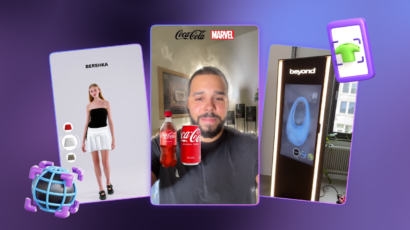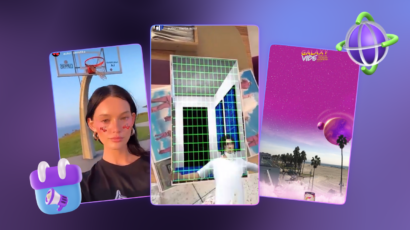Immersive technologies are creating new and exciting opportunities for marketers and companies to deeply engage with their target audience. Virtual reality (VR) and Augmented Reality (AR), each offering a unique set of benefits, come out as the main characters in this innovative technological journey.
However, what are the key differences between AR and VR?
Both provide distinctive experiences and for businesses hoping to fully realize their potential, it is essential to understand what sets them apart.
Key Differences:
- Nature of Immersion: AR – overlays digital content onto the real world, enhancing perception. VR – immerses users in a virtual environment, blocking out reality.
- Hardware Requirements: AR – uses smartphones or AR glasses, blending digital with reality. VR – Requires specialized headsets, offering full immersion.
- User Interaction: AR – interacts with digital overlays in the real world. VR – Engages with virtual objects and spaces intuitively.
- Applications: AR – product visualization, marketing campaigns, try-on experiences, data visualization. VR – training simulations, meetings, storytelling, gaming.
- Market Adoption: AR – widespread via smartphone apps and AR-enabled devices.
VR – increasing popularity with dedicated hardware.
Let’s explain their qualities better and show how businesses across industries may use these game-changing technologies to their benefit.
Augmented Reality VS Virtual Reality
AR is the process of superimposing digital content on the physical world to improve our experience of reality. To better understand it, just imagine using your smartphone to visualize how a new piece of furniture would look in your living room before making a purchase, or the feature to try on the product, basically any filter you meet in social media is the AR. It has many categories and types. All of them work according to the specified objective. Also, you don’t need any additional equipment glasses or other wearables, your phone lens is enough.
VR, on the other hand, immerses users in entirely virtual environments. This technology requires special wearables, we might say that it’s not as easily accessible as AR for instance. To experience VR, you have to put on a VR headset, and you will find yourself exploring a museum halfway across the world or undergoing immersive training simulations without leaving your office, as well as attending meetings on the other side of your city, without moving from your couch. The list goes on.
As already mentioned above, while AR offers seamless integration with our everyday devices like smartphones, VR requires specialized headsets for full immersion, which can be seen as a limitation due to the need for additional hardware.
In essence, AR and VR open up endless possibilities for businesses to engage with their audience. Businesses across industries can leverage AR and VR in numerous, innovative ways. For instance, AR can revolutionize marketing campaigns by offering interactive experiences for customers, such as virtual try-ons for fashion brands or AR-enhanced product packaging. VR shines in training simulations, providing lifelike scenarios for employees to practice skills in a safe environment, or facilitating virtual meetings and events for global teams. Again, it depends on the objectives and the goals of a specific company or brand.
Not relying just on words and stories, let’s take a look at the statistics that underscore the profound impact of these technologies. According to Statista, the AR/VR market is predicted to grow at a rate of 10.77 % per year (CAGR 2024–2028), with a projected value of US$58.1 billion by 2028. Moreover, the user adoption rate is projected to be 52.8% in 2024 and is expected to increase to 55.9% by 2028.
Nowadays Main Characters: Immersive Technologies
Augmented Reality and Virtual Reality emerge as powerful tools for advancing user engagement and crafting impactful experiences. The choice between these technologies depends on your specific objectives and target audience. By grasping the unique strengths of AR and VR, businesses can explore new possibilities and maintain a competitive edge in today’s world, where people are fed up with information and attention spans are getting lower and lower. You definitely need something to stand out, to be memorable. So, look no further, the answer is simple and lies right here. Make your own decision and take a step forward towards a successful future.
We’d love to hear your thoughts on AR and VR! Share your experiences and ideas in the comments below. If you’re interested in delving deeper into immersive technologies, check out the blog section on our website, where you can find many interesting articles about the usage and benefits of AR across various industries. For further insights and statistical data about Augmented Reality and Virtual Reality, here are must-know VR statistics by Gitnux, and more insights on AR by Exploding Topics.
Have fun, and remember that being tech-savvy is the key to success!







